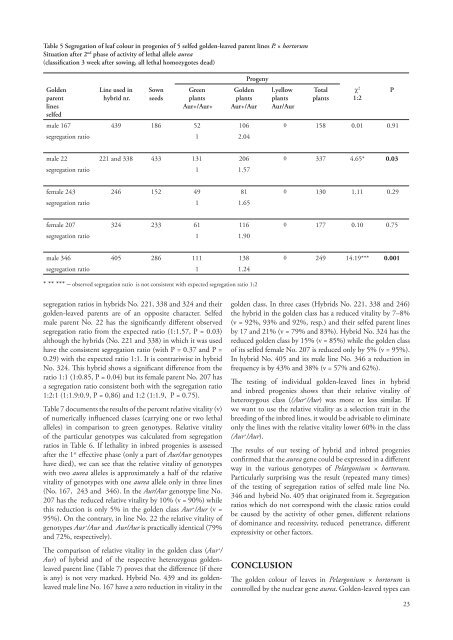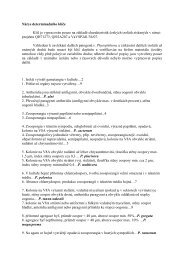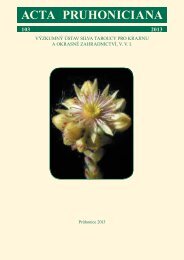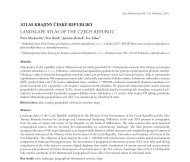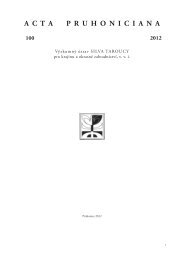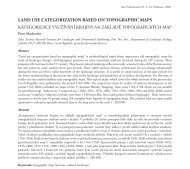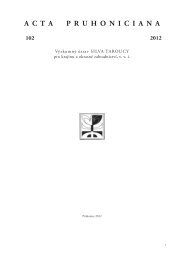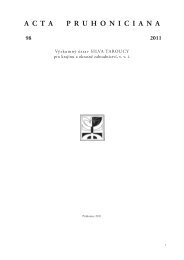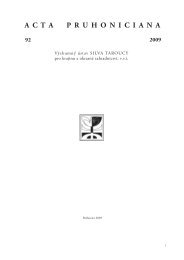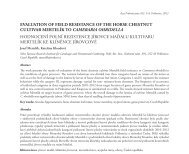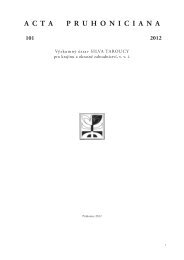Acta 93.indd - Výzkumný ústav Silva Taroucy pro krajinu a okrasné ...
Acta 93.indd - Výzkumný ústav Silva Taroucy pro krajinu a okrasné ...
Acta 93.indd - Výzkumný ústav Silva Taroucy pro krajinu a okrasné ...
You also want an ePaper? Increase the reach of your titles
YUMPU automatically turns print PDFs into web optimized ePapers that Google loves.
Table 5 Segregation of leaf colour in <strong>pro</strong>genies of 5 selfed golden-leaved parent lines P. × hortorumSituation after 2 nd phase of activity of lethal allele aurea(classification 3 week after sowing, all lethal homozygotes dead)GoldenparentlinesselfedLine used inhybrid nr.SownseedsGreenplantsAur+/Aur+ProgenyGoldenplantsAur+/Aurl.yellowplantsAur/AurTotalplantsmale 167 439 186 52 106 0 158 0.01 0.91segregation ratio 1 2.04 1:2Pmale 22 221 and 338 433 131 206 0 337 4.65* 0.03segregation ratio 1 1.57female 243 246 152 49 81 0 130 1.11 0.29segregation ratio 1 1.65female 207 324 233 61 116 0 177 0.10 0.75segregation ratio 1 1.90male 346 405 286 111 138 0 249 14.19*** 0.001segregation ratio 1 1.24* ** *** – observed segregation ratio is not consistent with expected segregation ratio 1:2segregation ratios in hybrids No. 221, 338 and 324 and theirgolden-leaved parents are of an opposite character. Selfedmale parent No. 22 has the significantly different observedsegregation ratio from the expected ratio (1:1.57, P = 0.03)although the hybrids (No. 221 and 338) in which it was usedhave the consistent segregation ratio (with P = 0.37 and P =0.29) with the expected ratio 1:1. It is contrariwise in hybridNo. 324. This hybrid shows a significant difference from theratio 1:1 (1:0.85, P = 0.04) but its female parent No. 207 hasa segregation ratio consistent both with the segregation ratio1:2:1 (1:1.9:0.9, P = 0,86) and 1:2 (1:1.9, P = 0.75).Table 7 documents the results of the percent relative vitality (v)of numerically influenced classes (carrying one or two lethalalleles) in comparison to green genotypes. Relative vitalityof the particular genotypes was calculated from segregationratios in Table 6. If lethality in inbred <strong>pro</strong>genies is assessedafter the 1 st effective phase (only a part of Aur/Aur genotypeshave died), we can see that the relative vitality of genotypeswith two aurea alleles is ap<strong>pro</strong>ximately a half of the relativevitality of genotypes with one aurea allele only in three lines(No. 167, 243 and 346). In the Aur/Aur genotype line No.207 has the reduced relative vitality by 10% (v = 90%) whilethis reduction is only 5% in the golden class Aur + /Aur (v =95%). On the contrary, in line No. 22 the relative vitality ofgenotypes Aur + /Aur and Aur/Aur is practically identical (79%and 72%, respectively).The comparison of relative vitality in the golden class (Aur + /Aur) of hybrid and of the respective heterozygous goldenleavedparent line (Table 7) <strong>pro</strong>ves that the difference (if thereis any) is not very marked. Hybrid No. 439 and its goldenleavedmale line No. 167 have a zero reduction in vitality in thegolden class. In three cases (Hybrids No. 221, 338 and 246)the hybrid in the golden class has a reduced vitality by 7–8%(v = 92%, 93% and 92%, resp.) and their selfed parent linesby 17 and 21% (v = 79% and 83%). Hybrid No. 324 has thereduced golden class by 15% (v = 85%) while the golden classof its selfed female No. 207 is reduced only by 5% (v = 95%).In hybrid No. 405 and its male line No. 346 a reduction infrequency is by 43% and 38% (v = 57% and 62%).The testing of individual golden-leaved lines in hybridand inbred <strong>pro</strong>genies shows that their relative vitality ofheterozygous class ((Aur + /Aur) was more or less similar. Ifwe want to use the relative vitality as a selection trait in thebreeding of the inbred lines, it would be advisable to eliminateonly the lines with the relative vitality lower 60% in the class(Aur + /Aur).The results of our testing of hybrid and inbred <strong>pro</strong>geniesconfirmed that the aurea gene could be expressed in a differentway in the various genotypes of Pelargonium × hortorum.Particularly surprising was the result (repeated many times)of the testing of segregation ratios of selfed male line No.346 and hybrid No. 405 that originated from it. Segregationratios which do not correspond with the classic ratios couldbe caused by the activity of other genes, different relationsof dominance and recessivity, reduced penetrance, differentexpressivity or other factors.CONCLUSIONThe golden colour of leaves in Pelargonium × hortorum iscontrolled by the nuclear gene aurea. Golden-leaved types can23


